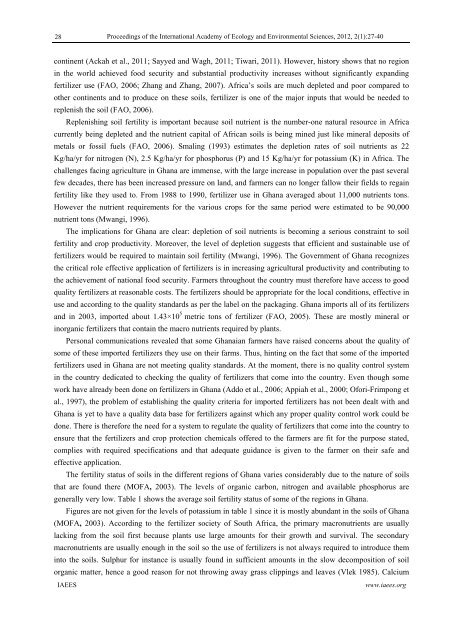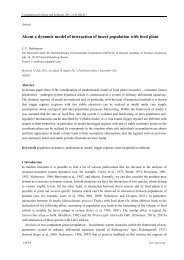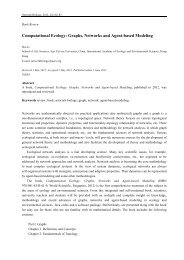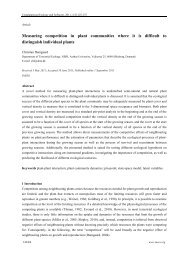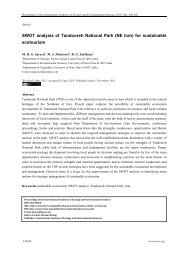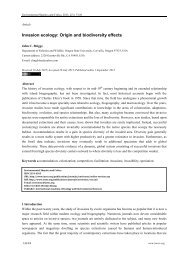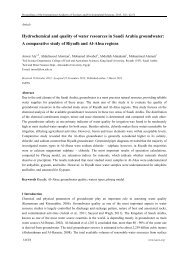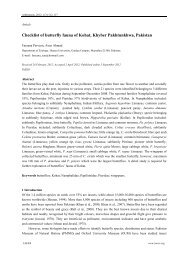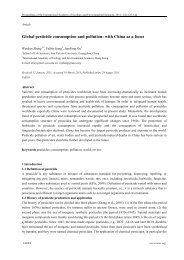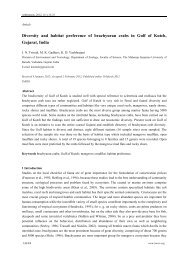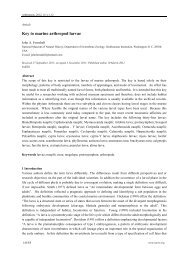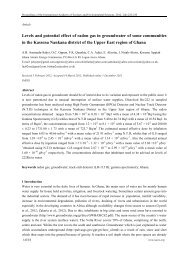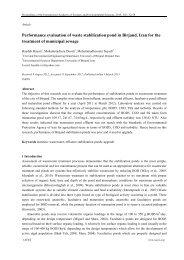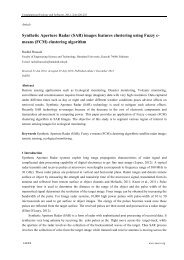Quality control analysis of imported fertilizers used in Ghana: the ...
Quality control analysis of imported fertilizers used in Ghana: the ...
Quality control analysis of imported fertilizers used in Ghana: the ...
You also want an ePaper? Increase the reach of your titles
YUMPU automatically turns print PDFs into web optimized ePapers that Google loves.
28<br />
Proceed<strong>in</strong>gs <strong>of</strong> <strong>the</strong> International Academy <strong>of</strong> Ecology and Environmental Sciences, 2012, 2(1):27-40<br />
cont<strong>in</strong>ent (Ackah et al., 2011; Sayyed and Wagh, 2011; Tiwari, 2011). However, history shows that no region<br />
<strong>in</strong> <strong>the</strong> world achieved food security and substantial productivity <strong>in</strong>creases without significantly expand<strong>in</strong>g<br />
fertilizer use (FAO, 2006; Zhang and Zhang, 2007). Africa’s soils are much depleted and poor compared to<br />
o<strong>the</strong>r cont<strong>in</strong>ents and to produce on <strong>the</strong>se soils, fertilizer is one <strong>of</strong> <strong>the</strong> major <strong>in</strong>puts that would be needed to<br />
replenish <strong>the</strong> soil (FAO, 2006).<br />
Replenish<strong>in</strong>g soil fertility is important because soil nutrient is <strong>the</strong> number-one natural resource <strong>in</strong> Africa<br />
currently be<strong>in</strong>g depleted and <strong>the</strong> nutrient capital <strong>of</strong> African soils is be<strong>in</strong>g m<strong>in</strong>ed just like m<strong>in</strong>eral deposits <strong>of</strong><br />
metals or fossil fuels (FAO, 2006). Smal<strong>in</strong>g (1993) estimates <strong>the</strong> depletion rates <strong>of</strong> soil nutrients as 22<br />
Kg/ha/yr for nitrogen (N), 2.5 Kg/ha/yr for phosphorus (P) and 15 Kg/ha/yr for potassium (K) <strong>in</strong> Africa. The<br />
challenges fac<strong>in</strong>g agriculture <strong>in</strong> <strong>Ghana</strong> are immense, with <strong>the</strong> large <strong>in</strong>crease <strong>in</strong> population over <strong>the</strong> past several<br />
few decades, <strong>the</strong>re has been <strong>in</strong>creased pressure on land, and farmers can no longer fallow <strong>the</strong>ir fields to rega<strong>in</strong><br />
fertility like <strong>the</strong>y <strong>used</strong> to. From 1988 to 1990, fertilizer use <strong>in</strong> <strong>Ghana</strong> averaged about 11,000 nutrients tons.<br />
However <strong>the</strong> nutrient requirements for <strong>the</strong> various crops for <strong>the</strong> same period were estimated to be 90,000<br />
nutrient tons (Mwangi, 1996).<br />
The implications for <strong>Ghana</strong> are clear: depletion <strong>of</strong> soil nutrients is becom<strong>in</strong>g a serious constra<strong>in</strong>t to soil<br />
fertility and crop productivity. Moreover, <strong>the</strong> level <strong>of</strong> depletion suggests that efficient and susta<strong>in</strong>able use <strong>of</strong><br />
<strong>fertilizers</strong> would be required to ma<strong>in</strong>ta<strong>in</strong> soil fertility (Mwangi, 1996). The Government <strong>of</strong> <strong>Ghana</strong> recognizes<br />
<strong>the</strong> critical role effective application <strong>of</strong> <strong>fertilizers</strong> is <strong>in</strong> <strong>in</strong>creas<strong>in</strong>g agricultural productivity and contribut<strong>in</strong>g to<br />
<strong>the</strong> achievement <strong>of</strong> national food security. Farmers throughout <strong>the</strong> country must <strong>the</strong>refore have access to good<br />
quality <strong>fertilizers</strong> at reasonable costs. The <strong>fertilizers</strong> should be appropriate for <strong>the</strong> local conditions, effective <strong>in</strong><br />
use and accord<strong>in</strong>g to <strong>the</strong> quality standards as per <strong>the</strong> label on <strong>the</strong> packag<strong>in</strong>g. <strong>Ghana</strong> imports all <strong>of</strong> its <strong>fertilizers</strong><br />
and <strong>in</strong> 2003, <strong>imported</strong> about 1.43×10 5 metric tons <strong>of</strong> fertilizer (FAO, 2005). These are mostly m<strong>in</strong>eral or<br />
<strong>in</strong>organic <strong>fertilizers</strong> that conta<strong>in</strong> <strong>the</strong> macro nutrients required by plants.<br />
Personal communications revealed that some <strong>Ghana</strong>ian farmers have raised concerns about <strong>the</strong> quality <strong>of</strong><br />
some <strong>of</strong> <strong>the</strong>se <strong>imported</strong> <strong>fertilizers</strong> <strong>the</strong>y use on <strong>the</strong>ir farms. Thus, h<strong>in</strong>t<strong>in</strong>g on <strong>the</strong> fact that some <strong>of</strong> <strong>the</strong> <strong>imported</strong><br />
<strong>fertilizers</strong> <strong>used</strong> <strong>in</strong> <strong>Ghana</strong> are not meet<strong>in</strong>g quality standards. At <strong>the</strong> moment, <strong>the</strong>re is no quality <strong>control</strong> system<br />
<strong>in</strong> <strong>the</strong> country dedicated to check<strong>in</strong>g <strong>the</strong> quality <strong>of</strong> <strong>fertilizers</strong> that come <strong>in</strong>to <strong>the</strong> country. Even though some<br />
work have already been done on <strong>fertilizers</strong> <strong>in</strong> <strong>Ghana</strong> (Addo et al., 2006; Appiah et al., 2000; Ofori-Frimpong et<br />
al., 1997), <strong>the</strong> problem <strong>of</strong> establish<strong>in</strong>g <strong>the</strong> quality criteria for <strong>imported</strong> <strong>fertilizers</strong> has not been dealt with and<br />
<strong>Ghana</strong> is yet to have a quality data base for <strong>fertilizers</strong> aga<strong>in</strong>st which any proper quality <strong>control</strong> work could be<br />
done. There is <strong>the</strong>refore <strong>the</strong> need for a system to regulate <strong>the</strong> quality <strong>of</strong> <strong>fertilizers</strong> that come <strong>in</strong>to <strong>the</strong> country to<br />
ensure that <strong>the</strong> <strong>fertilizers</strong> and crop protection chemicals <strong>of</strong>fered to <strong>the</strong> farmers are fit for <strong>the</strong> purpose stated,<br />
complies with required specifications and that adequate guidance is given to <strong>the</strong> farmer on <strong>the</strong>ir safe and<br />
effective application.<br />
The fertility status <strong>of</strong> soils <strong>in</strong> <strong>the</strong> different regions <strong>of</strong> <strong>Ghana</strong> varies considerably due to <strong>the</strong> nature <strong>of</strong> soils<br />
that are found <strong>the</strong>re (MOFA, 2003). The levels <strong>of</strong> organic carbon, nitrogen and available phosphorus are<br />
generally very low. Table 1 shows <strong>the</strong> average soil fertility status <strong>of</strong> some <strong>of</strong> <strong>the</strong> regions <strong>in</strong> <strong>Ghana</strong>.<br />
Figures are not given for <strong>the</strong> levels <strong>of</strong> potassium <strong>in</strong> table 1 s<strong>in</strong>ce it is mostly abundant <strong>in</strong> <strong>the</strong> soils <strong>of</strong> <strong>Ghana</strong><br />
(MOFA, 2003). Accord<strong>in</strong>g to <strong>the</strong> fertilizer society <strong>of</strong> South Africa, <strong>the</strong> primary macronutrients are usually<br />
lack<strong>in</strong>g from <strong>the</strong> soil first because plants use large amounts for <strong>the</strong>ir growth and survival. The secondary<br />
macronutrients are usually enough <strong>in</strong> <strong>the</strong> soil so <strong>the</strong> use <strong>of</strong> <strong>fertilizers</strong> is not always required to <strong>in</strong>troduce <strong>the</strong>m<br />
<strong>in</strong>to <strong>the</strong> soils. Sulphur for <strong>in</strong>stance is usually found <strong>in</strong> sufficient amounts <strong>in</strong> <strong>the</strong> slow decomposition <strong>of</strong> soil<br />
organic matter, hence a good reason for not throw<strong>in</strong>g away grass clipp<strong>in</strong>gs and leaves (Vlek 1985). Calcium<br />
IAEES<br />
www.iaees.org


